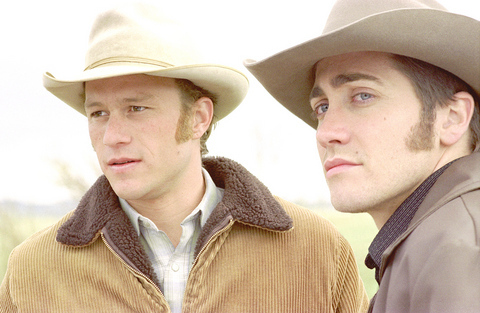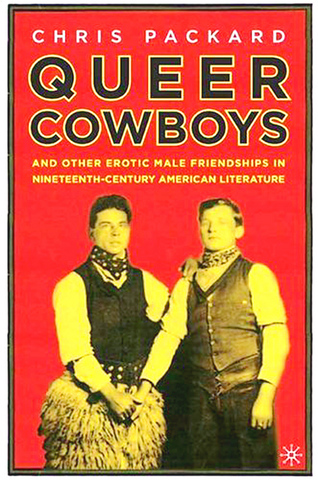Brokeback Mountain isn't the first popular fiction featuring cowboys with more than roping and wrangling on their minds.
Our eros has always been cowboys, according to Chris Packard, author of Queer Cowboys, an analysis of 19th century frontier writings about erotic male relationships that may have been sexual in nature.
"I use those words `erotic' and `sexual' very carefully," Packard said. "Sexuality is different from eroticism. My book tries to point out these are homoerotic friendships, whether they're sexual is not part of the literature. Unless you have evidence, you really have to err on the side of eroticism."

PHOTO: AP
Queer Cowboys uses excerpts from authors such as Mark Twain, Owen Wister and James Fenimore Cooper to make Packard's case that homoerotic bonds in the Old West were common and socially accepted. Vintage photographs depict men romantically touching or dancing together while women stand aside. Frederic Remington's sketches of cowboys sharing a haircut and exiting a tent are suggestively posed.
Reading between the lines is necessary in some cases, such as this portion of Badger Clark's 1917 poem, The Lost Pardner, which could pass as a plot outline of Brokeback Mountain:
"We loved each other in the way men do

PHOTO COURTESY OF AMAZON
And never spoke about it, Al and me,
But we both knowed, and knowin' it so true
Was more than any woman's kiss could be.
We knowed -- and if the way was smooth or rough,
The weather shine or pour,
While I had him the rest seemed good enough
But he ain't here no more!"
Queer Cowboys joins Ang Lee's film as elements of a budding revision of Western archetypes, especially the ruggedly heterosexual American cowboy, the myth of self-reliant men with checkered pasts seeking fresh starts on the lawless range. Dime novels of the era romanticized gunfights and campfire confessions but seldom addressed frontier sexuality except in code phrases such as a cowboy's "sex hunger," crude nicknames for genitalia and "mastering passion" lessons passed down to greenhorns. Wister's The Virginian had two cowboys practicing a wedding ceremony. In these books, settling down with a traditional family is considered the end of the adventure.
Until Brokeback Mountain, Western movies also mostly coded homoerotic themes. Looking back we wonder about the closeness of Butch Cassidy and the Sundance Kid, and detect flirting among gunslingers in The Wild Bunch. Billy the Kid's murder in The Left Handed Gun plays like a crime of gay passion. Val Kilmer's Doc Holliday in Tombstone promising to be "your huckleberry" to an adversary was fey on first impression. Reading Packard's take on the homoerotic subtext of Twain's The Adventures of Huckleberry Finn turns Doc's "huckleberry" threat into a come-on.
The most notable example of Hollywood's subversion of straight cowboy images is Howard Hawks' 1948 classic Red River, featuring John Ireland as a tough guy with the effeminate name Cherry Valance.
Cherry makes a veiled pass at a cowboy played by Montgomery Clift, whose real-life homosexuality was barely concealed by the studio system, by admiring his gun and comparing women to Swiss watches. "You ever had a (suggestive pause) Swiss watch?" Cherry asks with a lascivious smile.
Clift's film debut also includes a mocking dance with the ultimate cowboy icon, John Wayne, that is slightly flirtatious in hindsight. Any suggestion the Duke would have anything to do with expressing homosexual themes makes some people gasp.
That's exactly the reaction Packard seeks.
"Everybody should appreciate shock," he said. "Basically, what happens after the shock, after the recoiling, I hope, is some reflection, some wonder, `Why am I shocked?' Inquiring minds don't linger on shock then leap to rejection. And those people who do leap to rejection after the shock? That's just their limitation."
Packard's analysis of frontier literature could be slanted by modern perspective. The word "homosexual" wasn't coined until the late 19th century and "queer" simply meant something odd. Perhaps the vaguely erotic prose and images cited in Queer Cowboys are products of a naive society that hadn't yet passed judgment on gay intimacy. Packard acknowledged that possibility.
"But what else can we do except use our culture and knowledge to look backward in time?" he said. "We can't escape the knowledge that has accumulated in the last 25 years regarding gay and lesbian rights and the emergence of gay culture. You can't do away with that. You can't `not know' that. You look back in time, take current knowledge and apply it. Culture continues to accumulate meaning.
"You wonder if people back then would even know what to call this, if there was even a word for it. But there was a different set of rules about sexuality, that's for sure."
Rules changed over the decades from anything goes to nothing revealed. Attempts by Sigmund Freud and Alfred Kinsey to illuminate homosexual urges repulsed some people, while homophobic undertones of the McCarthy hearings lumped gays with criminals and communists in terms of undermining the American way.
The subsequent rise of gay rights and a bolder sense of artistic freedom refreshed the issue. Packard senses a change in grudging acceptance of his ideas, recalling an exchange with a former rodeo bull rider at a panel discussion of the gay West topic.
"He hadn't seen any actual sexuality on the rodeo circuit," Packard said. "But he didn't deny that friendships in that very macho community were stronger than other bonds. He questioned the validity of my research but he couldn't deny that eroticism."
Which begs the question: What would someone like Twain think about Packard's take on his writings?
"I would love to talk to Twain and find out what he would say," Packard said. "I think he would have a real fun twinkle in his eye, then deny it forever."

May 11 to May 18 The original Taichung Railway Station was long thought to have been completely razed. Opening on May 15, 1905, the one-story wooden structure soon outgrew its purpose and was replaced in 1917 by a grandiose, Western-style station. During construction on the third-generation station in 2017, workers discovered the service pit for the original station’s locomotive depot. A year later, a small wooden building on site was determined by historians to be the first stationmaster’s office, built around 1908. With these findings, the Taichung Railway Station Cultural Park now boasts that it has

Wooden houses wedged between concrete, crumbling brick facades with roofs gaping to the sky, and tiled art deco buildings down narrow alleyways: Taichung Central District’s (中區) aging architecture reveals both the allure and reality of the old downtown. From Indigenous settlement to capital under Qing Dynasty rule through to Japanese colonization, Taichung’s Central District holds a long and layered history. The bygone beauty of its streets once earned it the nickname “Little Kyoto.” Since the late eighties, however, the shifting of economic and government centers westward signaled a gradual decline in the area’s evolving fortunes. With the regeneration of the once

The latest Formosa poll released at the end of last month shows confidence in President William Lai (賴清德) plunged 8.1 percent, while satisfaction with the Lai administration fared worse with a drop of 8.5 percent. Those lacking confidence in Lai jumped by 6 percent and dissatisfaction in his administration spiked up 6.7 percent. Confidence in Lai is still strong at 48.6 percent, compared to 43 percent lacking confidence — but this is his worst result overall since he took office. For the first time, dissatisfaction with his administration surpassed satisfaction, 47.3 to 47.1 percent. Though statistically a tie, for most

In February of this year the Taipei Times reported on the visit of Lienchiang County Commissioner Wang Chung-ming (王忠銘) of the Chinese Nationalist Party (KMT) and a delegation to a lantern festival in Fuzhou’s Mawei District in Fujian Province. “Today, Mawei and Matsu jointly marked the lantern festival,” Wang was quoted as saying, adding that both sides “being of one people,” is a cause for joy. Wang was passing around a common claim of officials of the People’s Republic of China (PRC) and the PRC’s allies and supporters in Taiwan — KMT and the Taiwan People’s Party — and elsewhere: Taiwan and